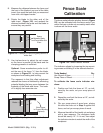
-68-
Model G0690/G0691 (Mfg. 11/10+)
Spreader or Riving
Knife Alignment
Checking Alignment
The blade guard spreader and riving knife must
be aligned with the blade when installed. If the
spreader/riving knife is not aligned with the blade,
then the workpiece will before forced sideways
during the cut, which will increase the risk of kick-
back.
Tools Needed Qty
Straightedge ...................................................... 1
To check the spreader/riving knife alignment:
1. DISCONNECT THE SAW FROM POWER!
2. Raise the saw blade to the maximum height
so you have easy working access.
3. Place the straightedge against the top and
bottom of blade and spreader/riving knife,
as shown in Figure 114. The spreader/riv-
ing knife should be be parallel with the blade
along its length at both positions, and it will
be in the "Alignment Zone," as shown in
Figure 115.
Figure 115. Spreader/riving knife alignment
zone.
Alignment
Zone
Spreader or
Riving Knife
Blade
— If the spreader/riving knife is not parallel
with the blade and inside the alignment
zone, then it needs to be adjusted. Proceed
to Adjusting Alignment instructions.
— If the spreader/riving knife is not parallel
with the blade at either the top or bottom, it
may be bent.
4. Remove the spreader/riving knife and place
it on a flat surface and check to see if the
spreader/riving knife lays evenly along its
length.
— If the spreader/riving knife does not
lay evenly, proceed to Adjusting Bent
Spreader/Riving Knife on Page 69.
Adjusting Alignment
The spreader/riving knife mounting position can
be adjusted into alignment with the blade using
the set screws on the spreader/riving knife mount-
ing block.
Possible Tools Needed Qty
Hex Wrench 3mm .............................................. 1
Hex Wrench 5mm .............................................. 1
To adjust the spreader/riving knife position:
1. DISCONNECT THE SAW FROM POWER!
2. Remove the table insert.
Figure 114. Checking top and bottom riving knife
parallelism with blade.
Table
Top Alignment
Bottom Alignment


















